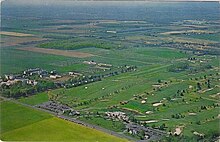Bangladeshi Americans
[12] Immigrants from present-day Bangladesh have been in the United States since at least the First World War, originating from East Bengal of British India.[21] Bangladeshi Americans are largely concentrated in metropolitan areas in the Northeast, Mid-Atlantic, and Great Lakes regions of the country, especially working-class neighborhoods and suburbs.Centered on 169th Street and Hillside Avenue, Jamaica, Queens, has become a popular draw due to the large number of Bengladeshi restaurants and grocery stores.Sagar Restaurant, Gharoa, Deshi Shaad, Kabir's Bakery, and other stores in Queens are attractions for the Bangladeshi community from throughout New York City.The largest numbers of Bangladeshi Americans now live in the Queens neighborhoods of Jamaica, Jackson Heights, Hollis, and Briarwood.[27] More affluent Bangladeshis have relocated to Long Island, largely due to many Bengladeshi-owned pharmaceutical companies that also employ many Bengladeshis there.The monument pays tribute to those killed in Pakistan in 1952 while protesting the country's ban on the use of Bangladeshis' native language Bangla (বাংলা).[38] In a 2013, NPR discussion with a member of the Economic Policy Institute and co-author of the book The Myth of the Model Minority Rosalind Chou who is also a professor of sociology.Republican President Richard Nixon's support of Pakistan during Bangladesh's struggle for independence partly swayed Bangladeshis to the Democratic Party.Before the colonization of South Asia by the Turkic and subsequent British Empires, folk religion in villages in the Bengal region incorporated elements of Hinduism, Buddhism, and Islam to varying degrees.In North America, Bangladeshis residing in rural areas often practice their faith at home and make special trips during community holidays like Ramadan and Durga Puja.



BengaliNew YorkNew JerseyVirginiaMichiganLos AngelesSylhetiChittagonianEnglishHinduismChristianityBuddhismIrreligionatheismagnosticismsecularismAsian AmericansSouth Asian AmericansBengali AmericanBangladeshi diasporaBangladeshisromanizedAmerican citizensBangladeshiBengali speaking MuslimsPaterson, New JerseyAtlantic City, New JerseyMonroe TownshipMiddlesex CountyFirst World WarEast BengalBritish Indiaindependence of BangladeshPatersonAtlantic CityMuslim AmericansBaishakhi MelaBaishakhiNew York City Metropolitan AreaCentralLong IslandexurbanaffluentWestern HemisphereHamtramck, MichiganWarren, MichiganCenter Line, MichiganDetroit, MichiganHyattsville, MarylandSeven Corners, VirginiaNew York, New YorkManchester, ConnecticutLincolnia, VirginiaBailey's Crossroads, VirginiaGreenbelt, MarylandElmont, New YorkWaterbury, ConnecticutSouth Laurel, MarylandArlington, VirginiaFayetteville, ArkansasIrving, TexasReno, NevadaNew York, NY/NJ/CT/PAQueensDetroit, MIWashington, DC/VA/MD/WVDallas-Fort Worth, TXBuffalo, NYAtlanta, GAHartford, CTPhiladelphia, PApermanent residentJackson Heights, QueensWoodsideElmhurstManhattanCurry RowJamaica, QueensHollisParkchester, BronxOzone Park, QueensCity Line, BrooklynBuffalo, New YorkBrooklyn6th StreetAstoriaStaten IslandLimited English proficiencyBriarwoodQueens VillageThe Bronxgrocery storesSonali Bankfinancial institutionPakistanBangla (বাংলা)The Recordmedian household income2000 U.S. CensusDemocratic PartyRichard Nixon2012 U.S. presidential electionBarack Obama2016 U.S. presidential electionHillary Clinton2020 U.S. presidential electionJoe BidenBengali cuisineCentral New JerseySylhet DivisionChittagongCox's BazarNoakhaillaNoakhali DistrictcolonizationTurkicBritishfolk religionBengalmodern periodRamadanDurga PujaList of Bangladeshi AmericansSears TowerFazlur Rahman KhanAbul Hussam